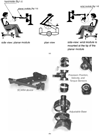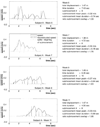Robot-aided neurorehabilitation
- PMID: 9535526
- PMCID: PMC2692541
- DOI: 10.1109/86.662623
Robot-aided neurorehabilitation
Abstract
Our goal is to apply robotics and automation technology to assist, enhance, quantify, and document neurorehabilitation. This paper reviews a clinical trial involving 20 stroke patients with a prototype robot-aided rehabilitation facility developed at the Massachusetts Institute of Technology, Cambridge, (MIT) and tested at Burke Rehabilitation Hospital, White Plains, NY. It also presents our approach to analyze kinematic data collected in the robot-aided assessment procedure. In particular, we present evidence 1) that robot-aided therapy does not have adverse effects, 2) that patients tolerate the procedure, and 3) that peripheral manipulation of the impaired limb may influence brain recovery. These results are based on standard clinical assessment procedures. We also present one approach using kinematic data in a robot-aided assessment procedure.
Figures










References
-
- Butefisch C, Hummelsheim H, Denzler P, Mauritz KH. Repetitive training of isolated movements improves the outcome of motor rehabilitation of the centrally paretic hand. J. Neurologic. Sci. 1995;vol. 130:59–68. - PubMed
-
- Taub E, Miller NE, Novack TA. Technique to improve chronic motor deficit after stroke. Arch. Phys. Med. Rehab. 1993;vol. 74:347–354. - PubMed
-
- Wolf SL, Lecraw DE, Barton LA, Jann BB. Forced use of hemiplegic upper extremities to reverse the effect of learned nonuse among chronic stroke and head-injured patients. Exper. Neurol. 1989;vol. 104(no 2):125–132. - PubMed
-
- Dam M, Tonin P, Casson S, Ermani M, Pizzolato G, Iaia V, Battistin L. The effects of long-term rehabilitation therapy on poststroke hemiplegic patients. Stroke. 1993;vol. 24(no 8):1186–1191. - PubMed
Publication types
MeSH terms
Grants and funding
LinkOut - more resources
Full Text Sources
Other Literature Sources
Medical

